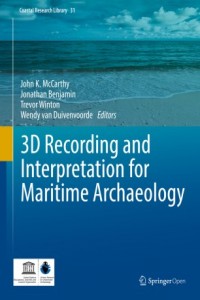John K. McCarthy(editor)
John McCarthy is an expert in 3D archaeological site recording and interpretation and is the author of several articles in leading international journals. John is an experienced field archaeologist and scientific diver with a dozen years of professional practice in archaeology in the UK, Ireland and Australia. In 2017, John was acknowledged for his leadership role on Project SAMPHIRE, which was awarded the prestigious European Union's Europe Nostra Award for cultural heritage. John is currently a PhD candidate at Flinders University, where he is focused on advancing methods and theory for 3D site recording, interpretation, reconstruction and dissemination methods for maritime archaeology. Prior to receiving a competitive international scholarship for doctoral research at Flinders, John was a Project Manager with Wessex Archaeology in Scotland. John is a graduate of Trinity College Dublin and received an MPhil from Queens University, Belfast.John McCarthy is an expert in 3D archaeological site recording and interpretation and is the author of several articles in leading international journals. John is an experienced field archaeologist and scientific diver with a dozen years of professional practice in archaeology in the UK, Ireland and Australia. In 2017, John was acknowledged for his leadership role on Project SAMPHIRE, which was awarded the prestigious European Union's Europe Nostra Award for cultural heritage. John is currently a PhD candidate at Flinders University, where he is focused on advancing methods and theory for 3D site recording, interpretation, reconstruction and dissemination methods for maritime archaeology. Prior to receiving a competitive international scholarship for doctoral research at Flinders, John was a Project Manager with Wessex Archaeology in Scotland. John is a graduate of Trinity College Dublin and received an MPhil from Queens University, Belfast.

Livres les plus vendus
Vous pourriez également être intéressé par ces livres écrits par le même auteur.
John McCarthy is an expert in 3D archaeological site recording and interpretation and is the author of several articles in leading international journals. John is an experienced field archaeologist and scientific diver with a dozen years of professional practice in archaeology in the UK, Ireland and Australia. In 2017, John was acknowledged for his leadership role on Project SAMPHIRE, which was awarded the prestigious European Union's Europe Nostra Award for cultural heritage. John is currently a PhD candidate at Flinders University, where he is focused on advancing methods and theory for 3D site recording, interpretation, reconstruction and dissemination methods for maritime archaeology. Prior to receiving a competitive international scholarship for doctoral research at Flinders, John was a Project Manager with Wessex Archaeology in Scotland. John is a graduate of Trinity College Dublin and received an MPhil from Queens University, Belfast.
Le plus populaire
3D Recording and Interpretation for Maritime Archaeology
This open access peer-reviewed volume was inspired by the UNESCO UNITWIN Network for Underwater Archaeology International Workshop held at Flinders University, Adelaide, Australia in November 2016. Content is based on, but not limited to, the work presented at the workshop which was dedicated to 3D recording and interpretation for maritime archaeology. The volume consists of contributions from leading international experts as well as up-and-coming early career researchers from around the globe. The content of the book includes recording and analysis of maritime archaeology through emerging technologies, including both practical and theoretical contributions. Topics include photogrammetric recording, laser scanning, marine geophysical 3D survey techniques, virtual reality, 3D modelling and reconstruction, data integration and Geographic Information Systems. The principal incentive for this publication is the ongoing rapid shift in the methodologies of maritime archaeology within recent years and a marked increase in the use of 3D and digital approaches. This convergence of digital technologies such as underwater photography and photogrammetry, 3D sonar, 3D virtual reality, and 3D printing has highlighted a pressing need for these new methodologies to be considered together, both in terms of defining the state-of-the-art and for consideration of future directions. As a scholarly publication, the audience for the book includes students and researchers, as well as professionals working in various aspects of archaeology, heritage management, education, museums, and public policy. It will be of special interest to those working in the field of coastal cultural resource management and underwater archaeology but will also be of broader interest to anyone interested in archaeology and to those in other disciplines who are now engaging with 3D recording and visualization.


